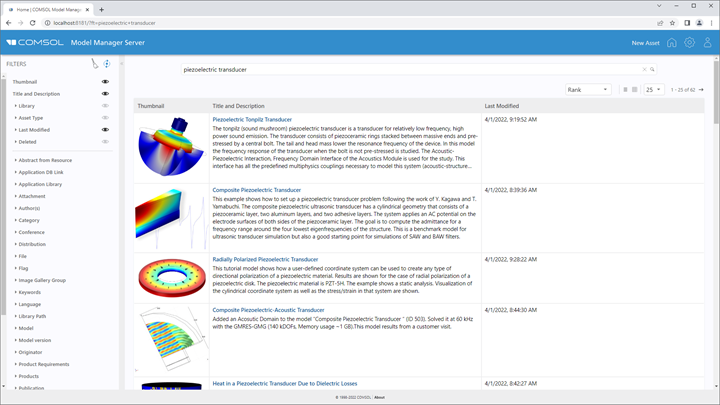COMSOL adds Model Manager Server extension to multiphysics simulation software
Asset management system reaches all elements of product and process design projects, facilitating the collaboration between stakeholders and colleagues working on a modeling and simulation project.
A web interface of the Model Manager server asset management system that shows different assets and metadata (asset type, author, distribution, etc.). Photo Credit: COMSOL Inc.
COMSOL Inc. (Burlington, Mass., U.S.) announces a major update to the COMSOL Multiphysics software version 6.0. The update builds out the Model Manager server with a web interface — an asset management system — to make it easier for COMSOL users and nonusers alike to manage models, simulation apps and supplementary and auxiliary files.
Through two decades of development, COMSOL Multiphysics has evolved from a software that solved partial differential equations to one that defines the nature of multiphysics modeling. In addition to Model Builder and Application Builder, COMSOL completes the environment for managing modeling and simulation projects for product and process design through the recently introduced Model Manager and the Model Manager server with its accompanying asset management system.
Released in Dec. 2021, the Model Manager enables users to:
- Search through models for particular parameter names and feature strings.
- Track model development through version control with model comparison and merging capabilities.
- Upload, link and administrate supplementary and auxiliary files to a modeling and simulation or development project.
The Model Manager has now been complemented by the Model Manager server’s asset management system, which is accessible through a web interface. In the asset management system, an asset can be considered as a container for links to your model versions, attached supplementary and auxiliary files, as well as various custom metadata fields. With the asset management system, you can itemize assets through model and app files, adding abstracts, setting permissions and even include thumbnail images of the model at hand.
The Model Manager server is a database system that can be managed from either the COMSOL Desktop or a web-based UI. A local installation of any license type of COMSOL Multiphysics with the Model Manager and a local database is usually the initial step for a modeling engineer to acclimatize themselves to how this system can be best used within their organization. From there, full deployment can occur by installing the Model Manager server on a central server. Local installations of COMSOL Multiphysics can connect to the central server with the Model Manager server.
According to COMSOL CTO Ed Fontes, the Model Manager server’s true power is not only in its ability to manage simulation data, but in being able to version control and audit the actual model-building process, such as easily broswing through the model tree of certain models or searching for specific features like domain settings, boundary conditions or study types to revisit, update or reuse.
Internal or external customers may use the database system to keep track and use results from a project. They may also use simulation apps and provide feedback about their measurement and test data by uploading them and reports to the relevant asset. Contributors on the model development can also add their auxiliary data, such as CAD files and specifications, to the project.

















